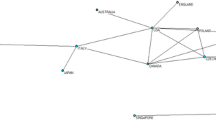Abstract
The trend toward collectivization in Astronomy during this century (1901–1996), as measured by the increase in the number of authors per paper, is analyzed. For this purpose, two leading astronomical journals:The Astrophysical Journal andMonthly Notices of the Royal Astronomical Society are surveyed. It is found that the average number of authors per paper has jumped from a little more than one in the first half of this century to about three at present. Most of this dramatic increase has taken place during the last 20–25 years. At the same time, the ratio ofcollective papers (three or more authors) to single-authored ones has passed from nearly zero to 3–4 at present. The latter means that collective papers were almost nonexistent until the fifties or sixties to become nowadays 3–4 times more frequent than single-authored ones. The reasons underlying the collectivization of Astronomy (and perhaps of all natural sciences) are analyzed. The growing professionalization of science accompanied by a massive influx of graduate studients into University research institutes, the revolution in communication, the pressure to publish in order to progress in a scientific career, and the growing complexity of knowledge are invoked as causes for the abandonment of the traditional individualism in science to a collective regime.
Similar content being viewed by others
References
J. Ziman,Prometheus Bound. Science in a Dynamical Steady State, Cambridge University Press, Cambridge, Great Britain, 1994.
J.-M. Lévy-Leblond, A. Jaubert,(Auto)critique de la Science, Editions du Seuil, Paris, 1975.
D. J. De Solla Price,Little Science, Big Science… and Beyond, Columbia University Press, New York, 1986.
B. L. Clarke, Multiple authorship trends in scientific papers,Science, 143 (1964) 822–824.
A. H. Abt, Some trends in American astronomical publications,Publications of the Astronomical Society of the Pacific, 93 (1981) 269–272.
A. H. Abt, Trends toward internationalization in astronomical literature,Publications of the Astronomical Society of the Pacific, 102 (1990) 368–372.
A. H. Abt, How long are astronomical papers remembered?,Publications of the Astronomical Society of the Pacific, 108 (1996) 1059–1061.
D. E. Osterbrock, Founded in 1895 by George E. Hale and James E. Keeler: The Astrophysical Journal centennial,Astrophysical Journal, 438 (1995) 1–7.
B. Glass, Science: Endless horizons or golden age?Science, 171 (1971) 23–29.
C. Mitcham, P. Siekevitz,Ethical Issues Associated with Scientific and Technological Research for the Military,C. Mitcham, P. Siekevitz, Eds.), the New York Academy of Sciences, 1989, p. IX.
J. M. Ziman, The collectivization of science (The Bernal Lecture, 1983).Proceedings of the Royal Society, London, B219 (1983) 1–19.
M. Harwit,Cosmic Discovery. The Search, Scope and Heritage of Astronomy, Harvester Press, Brighton, Great Britain, 1981.
J. Horgan,The End of Science. Facing the Limits of Knowledge in the Twilight of the Scientific Age, Addison-Wesley, USA, 1996.
Author information
Authors and Affiliations
Rights and permissions
About this article
Cite this article
Fernández, J.A. The transition from an individual science to a collective one: The case of astronomy. Scientometrics 42, 61–74 (1998). https://doi.org/10.1007/BF02465012
Received:
Issue Date:
DOI: https://doi.org/10.1007/BF02465012




